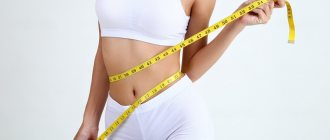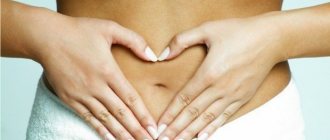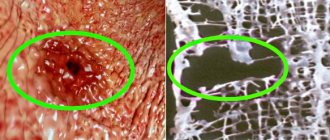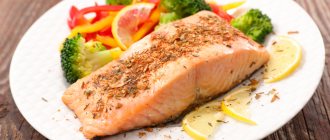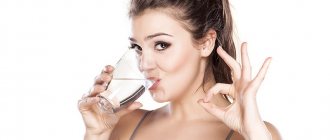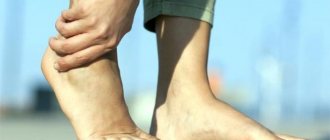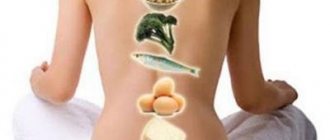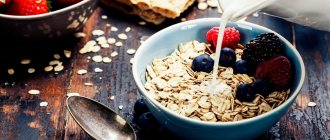The text is for informational purposes only. We strongly urge you not to use diets, resort to any therapeutic menus or fasting without medical supervision. We recommend reading: “Why you can’t go on a diet on your own.”
Dietary nutrition for gout is part of complex therapy aimed at reducing the symptoms of the disease. A proper diet will improve the patient’s condition from the first days of treatment.
General rules
Gout is a chronic relapsing disease based on a disorder of purine metabolism. of urates (uric acid salts) in the body
Signs, symptoms and treatment
The main diagnostic signs and symptoms include:
- An acute attack of arthritis of the metatarsophalangeal joint of the big toe (most often) in which there is a sharp cutting/burning pain in the affected joint on the legs, the skin over the joint becomes purplish and hot to the touch, and the joint swells. Any touch to it causes severe pain, which can last from 2-3 hours to 2-3 days. The most common is “gout of the legs,” but much less often the thumbs, elbows, knees, and ankle joints can also be affected.
- The presence of specific gouty nodes - tophi , which are deposits of sodium urate in soft tissues in the form of hard nodules, mainly on the extensor surface of the thighs, above the joints of the foot, leg and Achilles tendons.
- Increased levels of uric acid in the blood (based on poor diet or kidney disease).
Treatment of the disease is complex and the most important component of the treatment process is diet therapy. Therapeutic nutrition involves reducing the energy value of the diet (as a rule, patients with gout have increased body weight), limiting the intake of exogenous purines, as well as fats, which reduce the excretion of uric acid by the kidneys.
The main diet for gout of the legs is Dietary Table No. 6 with the aim of normalizing the metabolism of purines (nitrogen-containing organic compounds), reducing the level of uric acid and salts formed during the metabolism of purines, and shifting the urine reaction to the alkaline side. It is in an alkaline environment that the solubility of urates increases, the removal of uric acid from the body is accelerated and, at the same time, the process of their formation is disrupted.
The energy value of a therapeutic diet is about 2700-2800 Kcal. The nutrition is physiologically complete with a slight reduction in the diet of proteins to 70-80 g and fats, mainly refractory to 80-90 g. In the absence of obesity , the carbohydrate content is about 400 g. The amount of free liquid is 2 liters.
Diet for gout. The table provides for a strict restriction/prohibition of foods rich in purine bases and oxalic acid with a slight restriction of sodium chloride (up to 10 g/day). In this case, products that have an alkalizing effect (vegetables/fruits, milk) are introduced. To guide patients, special tables have been developed indicating the content of purine bases in food products.
| Product name | Approximate content of purine bases (mg/100 g of product) |
| Sprats | 87 |
| Beef | 80-100 |
| Sardines | 125 |
| Beef liver | 300 |
| Chicken | 110 |
| Peas | 105 |
| Herring | 128 |
| Veal | 150 |
| Rabbit | 65 |
| Salmon | 100 |
| Dry yeast | 750 |
| Beans | 75 |
| Soybeans | 90 |
| Mussels | 150 |
| Trout | 85 |
| Beef tongue | 72 |
| Wholemeal bread | 24 |
Such a table can be downloaded on the Internet, it can be printed and used when creating your menu.
Boiled meat for gout
There are no special requirements for the preparation of products, with the exception of meat processing. In order to reduce the purine content in the dish, meat is prepared exclusively by boiling. At the same time, the meat is pre-boiled briefly for 10-15 minutes, after which the broth is drained and further cooking continues. Outside the period of exacerbation, meat and fish dishes can be included in the menu no more than 2-3 times a week, and the amount of meat and fish per day should not exceed 150 g. Meals for gout are fractional, 5 times, in the intervals between meals - drink plenty of fluids.
The anti-gout diet involves fasting days (once a week) - cottage cheese-kefir - 400 g of low-fat cottage cheese and 1 liter of kefir; fruit - up to 1.5 kg of permitted vegetables/fruits, with an increase in fluid intake during this period to 3 liters (in the absence of contraindications).
Diet for gout during an exacerbation requires more careful formation of the diet. During an exacerbation of gout, it is necessary to completely exclude all meat and fish products from the diet. The optimal diet during this period is a vegetarian diet , including milk and vegetable soups, liquid cereals, fermented milk products, decoctions of vegetables and fruits, fruit juices, herbal teas. Exacerbation of the disease requires more frequent fasting days (optimally every other day). During this period, increased consumption of alkaline mineral waters is shown.
Diet for gout during an exacerbation
During an exacerbation of gout, a properly selected diet will help get rid of unpleasant painful symptoms and restore the mobility that a person loses during the development of inflammation. You can completely exclude meat and fish products from the menu.
Nutrition for gout involves more frequent fasting days (every other day). In case of exacerbation, you can use the following menu for 1 day:
- On an empty stomach: half a glass of preheated alkaline mineral water or rosehip decoction (you can use chicory).
- Breakfast: half a serving of oatmeal porridge (it should be liquid), a glass of milk. 11 o'clock: 1 glass of apple juice. Instead, you can eat raw apples (1 pc.).
- Lunch: pureed vegetable soup (half a serving), milk-based jelly. 17 hours: carrot or tomato juice (glass).
- Dinner: half a serving of liquid milk rice porridge, 1 glass of fruit compote (strawberries, pears, apples). 21 hours: a glass of kefir.
- At night: tea with milk and honey (not advisable for diabetes) or green tea without sugar - 1 glass.
This menu can be used until the symptoms of inflammation in the legs disappear.
Varieties
Diet 6E refers to a variety of Table No. 6 . Prescribed for similar indications in obese . The energy value is reduced to 1950-2000 Kcal (protein content at 70 g, fat at 80 g, carbohydrates at 250 g).
The consumption of simple carbohydrates (fresh wheat bread, sugar, honey, sweets, confectionery and flour products) and less complex carbohydrates (cereals) are mainly reduced. Meat intake is limited to 1-2 times a week. Eat small portions (fractional) up to 5-6 times a day, drink plenty of fluids, especially slightly alkaline mineral waters. Vegetables and fruits are best consumed raw, but can be baked and boiled. Since the diet is not physiologically complete, it can be prescribed for a period of no more than 2 weeks.
Nutrition for chronic gout
Outside of an exacerbation of the disease, it is necessary to follow a diet low in purines. It is useful to include dishes with plenty of vegetables in your diet. You can eat fruits and berries. Only vegetarian soups can be prepared.
It is mandatory to take fluids on an empty stomach and between meals. The best way to prepare food is by boiling and stewing. Meat, poultry and fish must be pre-boiled and the first broth drained, as it contains a large amount of purines. Meat and fish dishes can be consumed no more than two to three times a week.
Fasting days are held once a week. Fasting days activate the removal of metabolic products. On these days, you are allowed to eat one type of food. It can be low-fat kefir, cottage cheese, apples, watermelon. On fasting days you need to drink at least two and a half liters of water, but only if there are no contraindications from the urinary and cardiovascular systems.
Authorized Products
It is recommended to include most vegetables in the diet: white cabbage, carrots, zucchini, tomatoes, eggplant, cucumbers. Potatoes are especially useful. Fruits - plums, pears, apples, apricots, oranges and various berries.
It is recommended to cook various cereals with diluted milk and whole grain pasta. Meat in small quantities can include turkey, rabbit, and chicken. Soups are only allowed to be made vegetarian. The diet should include low-fat milk, fermented milk drinks, cottage cheese and dishes made from it, low-fat sour cream, and unsalted cheese.
It is allowed to eat chicken eggs (one per day) and boiled fish, white (dried) and black bread. Fats include vegetable oils (olive, flaxseed). Sweets included in the diet include marshmallows, marshmallows, marmalade, and non-chocolate candies. Be sure to include cucumber juice, lingonberry juice, and weakly mineralized alkaline mineral waters in your diet. Drink - decoction of rose hips, chicory, wheat bran, green tea, compotes, juices of vegetables, fruits, berries.
Table of permitted products
| Proteins, g | Fats, g | Carbohydrates, g | Calories, kcal | |
Vegetables and greens | ||||
| eggplant | 1,2 | 0,1 | 4,5 | 24 |
| zucchini | 0,6 | 0,3 | 4,6 | 24 |
| potato | 2,0 | 0,4 | 18,1 | 80 |
| carrot | 1,3 | 0,1 | 6,9 | 32 |
| cucumbers | 0,8 | 0,1 | 2,8 | 15 |
| tomatoes | 0,6 | 0,2 | 4,2 | 20 |
Fruits | ||||
| apricots | 0,9 | 0,1 | 10,8 | 41 |
| oranges | 0,9 | 0,2 | 8,1 | 36 |
| pears | 0,4 | 0,3 | 10,9 | 42 |
| plums | 0,8 | 0,3 | 9,6 | 42 |
| apples | 0,4 | 0,4 | 9,8 | 47 |
Nuts and dried fruits | ||||
| prunes | 2,3 | 0,7 | 57,5 | 231 |
Bakery products | ||||
| wheat bread | 8,1 | 1,0 | 48,8 | 242 |
| bran bread | 7,5 | 1,3 | 45,2 | 227 |
Confectionery | ||||
| jam | 0,3 | 0,2 | 63,0 | 263 |
| marshmallows | 0,8 | 0,0 | 78,5 | 304 |
| paste | 0,5 | 0,0 | 80,8 | 310 |
Raw materials and seasonings | ||||
| honey | 0,8 | 0,0 | 81,5 | 329 |
Dairy | ||||
| milk | 3,2 | 3,6 | 4,8 | 64 |
| kefir 2.5% | 2,8 | 2,5 | 3,9 | 50 |
| Ryazhenka 2.5% | 2,9 | 2,5 | 4,2 | 54 |
| curdled milk | 2,9 | 2,5 | 4,1 | 53 |
| acidophilus | 2,8 | 3,2 | 3,8 | 57 |
| yogurt | 4,3 | 2,0 | 6,2 | 60 |
Cheeses and cottage cheese | ||||
| sulguni cheese | 20,0 | 24,0 | 0,0 | 290 |
| cottage cheese 0.6% (low fat) | 18,0 | 0,6 | 1,8 | 88 |
Meat products | ||||
| rabbit | 21,0 | 8,0 | 0,0 | 156 |
Bird | ||||
| chicken | 16,0 | 14,0 | 0,0 | 190 |
| turkey | 19,2 | 0,7 | 0,0 | 84 |
Eggs | ||||
| chicken eggs | 12,7 | 10,9 | 0,7 | 157 |
Oils and fats | ||||
| butter | 0,5 | 82,5 | 0,8 | 748 |
| linseed oil | 0,0 | 99,8 | 0,0 | 898 |
| olive oil | 0,0 | 99,8 | 0,0 | 898 |
Non-alcoholic drinks | ||||
| green tea | 0,0 | 0,0 | 0,0 | — |
Juices and compotes | ||||
| juice | 0,3 | 0,1 | 9,2 | 40 |
| cucumber juice | 0,8 | 0,1 | 2,5 | 14 |
| * data is per 100 g of product | ||||
Fully or partially limited products
The diet limits the consumption of red meat (beef, lamb, pork) and strictly excludes the intake of animal by-products (beef tongue, pork liver kidneys, heart), as well as fatty varieties of sea fish and seafood (herring, mackerel, salmon, salmon, shrimp, mussels ), caviar and canned fish. It is not allowed to include any smoked, salted or pickled foods, animal (pork, beef, lamb) or cooking fat or butter in the diet. Soups and broths containing meat, fish and legumes are excluded.
Products rich in vegetable proteins (peas, beans, lentils, soybeans, beans), hot and spicy seasonings and spices (horseradish, mustard pepper), as well as products containing oxalic acid (sorrel, spinach, gelatin-containing dishes, bread kvass) are completely excluded , cocoa, coffee, jelly, chocolate, rhubarb). The ban includes cakes, cream pies, salty and spicy cheeses and a number of berries - raspberries, grapes, cranberries, figs.
The consumption of foods rich in carbohydrates in the diet is limited: pasta, fresh bread. It is undesirable to eat peppers, radishes, asparagus, and celery. Drinks include strong tea and black coffee. Drinking alcohol-containing drinks, especially red wines, beer and cognac, is prohibited. Limit consumption of salt, sweetened juices and soft drinks.
Table of prohibited products
| Proteins, g | Fats, g | Carbohydrates, g | Calories, kcal | |
Vegetables and greens | ||||
| beans | 6,0 | 0,1 | 8,5 | 57 |
| peas | 6,0 | 0,0 | 9,0 | 60 |
| cauliflower | 2,5 | 0,3 | 5,4 | 30 |
| chickpeas | 19,0 | 6,0 | 61,0 | 364 |
| rhubarb | 0,7 | 0,1 | 2,5 | 13 |
| radish | 1,2 | 0,1 | 3,4 | 19 |
| soybeans | 34,9 | 17,3 | 17,3 | 381 |
| asparagus | 1,9 | 0,1 | 3,1 | 20 |
| beans | 7,8 | 0,5 | 21,5 | 123 |
| horseradish | 3,2 | 0,4 | 10,5 | 56 |
| lentils | 24,0 | 1,5 | 42,7 | 284 |
| sorrel | 1,5 | 0,3 | 2,9 | 19 |
Fruits | ||||
| figs | 0,7 | 0,2 | 13,7 | 49 |
Berries | ||||
| cranberry | 0,5 | 0,0 | 6,8 | 26 |
| raspberries | 0,8 | 0,5 | 8,3 | 46 |
Flour and pasta | ||||
| pasta | 10,4 | 1,1 | 69,7 | 337 |
Chocolate | ||||
| chocolate | 5,4 | 35,3 | 56,5 | 544 |
Raw materials and seasonings | ||||
| mustard | 5,7 | 6,4 | 22,0 | 162 |
| mayonnaise | 2,4 | 67,0 | 3,9 | 627 |
Meat products | ||||
| pork | 16,0 | 21,6 | 0,0 | 259 |
| pork liver | 18,8 | 3,6 | 0,0 | 108 |
| pork kidneys | 13,0 | 3,1 | 0,0 | 80 |
| salo | 2,4 | 89,0 | 0,0 | 797 |
| beef | 18,9 | 19,4 | 0,0 | 187 |
| beef liver | 17,4 | 3,1 | 0,0 | 98 |
| beef brains | 9,5 | 9,5 | 0,0 | 124 |
| mutton | 15,6 | 16,3 | 0,0 | 209 |
| bacon | 23,0 | 45,0 | 0,0 | 500 |
Sausages | ||||
| smoked sausage | 28,2 | 27,5 | 0,0 | 360 |
Fish and seafood | ||||
| pink salmon | 20,5 | 6,5 | 0,0 | 142 |
| Red caviar | 32,0 | 15,0 | 0,0 | 263 |
| squid | 21,2 | 2,8 | 2,0 | 122 |
| shrimps | 22,0 | 1,0 | 0,0 | 97 |
| salmon | 19,8 | 6,3 | 0,0 | 142 |
| mussels | 9,1 | 1,5 | 0,0 | 50 |
| herring | 16,3 | 10,7 | — | 161 |
| salmon | 21,6 | 6,0 | — | 140 |
| mackerel | 18,0 | 13,2 | 0,0 | 191 |
| sprats | 17,4 | 32,4 | 0,4 | 363 |
Oils and fats | ||||
| animal fat | 0,0 | 99,7 | 0,0 | 897 |
| cooking fat | 0,0 | 99,7 | 0,0 | 897 |
Alcoholic drinks | ||||
| red dessert wine | 0,5 | 0,0 | 20,0 | 172 |
| vodka | 0,0 | 0,0 | 0,1 | 235 |
| cognac | 0,0 | 0,0 | 0,1 | 239 |
| liquor | 0,3 | 1,1 | 17,2 | 242 |
| beer | 0,3 | 0,0 | 4,6 | 42 |
Non-alcoholic drinks | ||||
| coffee | 0,2 | 0,0 | 0,3 | 2 |
| black tea | 20,0 | 5,1 | 6,9 | 152 |
| * data is per 100 g of product | ||||
Prohibited Products
For patients with gout, rich meat and fish broths, as well as soups based on them, are strictly prohibited. When cooked, they accumulate a huge amount of purine bases. Consuming even 100 ml of broth is highly likely to provoke another relapse of the disease. What else should be completely excluded from your diet:
- offal, fatty and lean red meat - pork, beef, lamb;
- fatty sea and river fish - herring, salmon, mackerel;
- seafood and red caviar;
- homemade and factory-made marinades, pickles and other preserves;
- seasonings and sauces - horseradish, mustard, black and allspice, mayonnaise, ketchup;
- cheeses rich in salt and spices,
- chocolate and other desserts with cocoa, sweet and savory pastries, protein, butter and custard;
- sorrel, spinach.
Nutritionists recommend not consuming or significantly limiting mushrooms in the daily menu. This is also true for asparagus, celery, radishes, bell peppers, cauliflower, legumes, and pasta.
Menu (Power Mode)
The menu for the week includes only permitted products, prepared taking into account recommended cooking methods. Below is a sample diet menu for gout for a week.
Monday
| Breakfast |
|
| Lunch |
|
| Dinner |
|
| Dinner |
|
| For the night |
|
Tuesday
| Breakfast |
|
| Lunch |
|
| Dinner |
|
| Dinner |
|
| For the night |
|
Wednesday
| Breakfast |
|
| Lunch |
|
| Dinner |
|
| Dinner |
|
| For the night |
|
Thursday
| Breakfast |
|
| Lunch |
|
| Dinner |
|
| Dinner |
|
| For the night |
|
Friday
| Breakfast |
|
| Lunch |
|
| Dinner |
|
| Dinner |
|
| For the night |
|
Saturday
| Breakfast |
|
| Lunch |
|
| Dinner |
|
| Dinner |
|
| For the night |
|
Sunday
| Breakfast |
|
| Lunch |
|
| Dinner |
|
| Dinner |
|
| For the night |
|
Fasting days for gout
A fasting menu for gout is planned for a week at once: this makes it easier for the patient to balance all the foods that he can eat. Borscht, soups, and lean cabbage soup are prepared with the addition of cereals and vegetables. Mushroom, fish and meat soups are undesirable.
A small amount of baked goods is allowed each day. Rye bread made from bran and second-grade flour are more suitable for the human body with gout. It is better to refuse butter dough.
Diet recipes
Below are recipes for some dietary dishes and the technology for their preparation.
First meal
Light puree soup
1 carrot, 1 onion, 2 tablespoons lemon juice, ½ teaspoon sugar, 2 tablespoons sunflower oil, 30 g cream.
We clean and chop the vegetables. Place the cooked carrots and onions in a pan with heated oil, put on the fire, and simmer for 7-8 minutes. Blend until puree. Add lemon juice, sugar and let it boil; when serving, add cream to the plate.
Second courses
Steamed chicken meatballs with gravy
Steamed chicken meatballs
Chicken fillet 350 g, 70 g onions, 30 ml milk, 1 chicken egg, 150 g boiled rice, 70 g white bread, pepper. Salt, herbs. For the gravy: 150 g carrots, 200 ml chicken broth, 50 g herbs, 70 g onions, vegetable oil, 50 g sour cream, 15 g wheat flour, salt, pepper, green onions for serving.
Cut the chicken fillet, put it in a blender, add onions, a raw chicken egg and bread soaked in milk, pepper, and dry dill. Grind thoroughly. Add boiled cold rice, fine table salt and mix the minced meatballs, let it sit for 20 minutes in the refrigerator. Form meatballs and steam for 6-8 minutes.
Sauté onions and carrots, add chicken broth, herbs, wheat flour, salt to taste and sour cream. Warm up over low heat. Place the steamed meatballs into the prepared gravy and cook for another 5-6 minutes, sprinkle with green onions.
Cottage cheese casserole
3 chicken eggs, 100 g semolina, 100 g sugar, 2 packs of cottage cheese, 200 g low-fat sour cream, dried fruits, salt, soda, slaked with lemon juice.
Mix all ingredients thoroughly, add 0.5 teaspoon of soda, slaked with lemon juice, and raisins. Pour the resulting mass into the prepared baking dish and bake in the oven at 180 degrees until lightly browned.
Comments from nutritionists
Many patients underestimate proper nutrition for gout. Meanwhile, a strict antipurine diet in combination with taking anti-gout drugs can significantly slow down the rate of progression of destruction of osteochondral tissue, prevent the formation of tophi and preserve the function of the musculoskeletal system as much as possible.
Some patients practice fasting, especially during an exacerbation. This should not be done, since during fasting the level of uric acid , which is extremely undesirable. Fasting days only.
Reviews and results
The overwhelming number of patients talk about the effectiveness of nutritional therapy for gout. Eating according to the menu of Dietary Table No. 6 allows you to quickly, together with medicinal drugs, normalize the metabolism in the body and relieve exacerbations.
- “... The diagnosis of gouty arthritis was made relatively recently (about a year ago), after the first attack. Tests confirmed the diagnosis. I carefully re-read all the information on the Internet about “what diet for gout, practical recommendations.” I carefully analyzed all the information and decided not just to go on a diet, but to completely change my lifestyle: I practice maximum consumption of fruits and vegetables, drink a lot of fluids, especially mineral water and herbal teas, reduced my weight to normal, introduced morning walking walks. The condition has improved significantly, there are no attacks yet”;
- “... I have not yet been diagnosed with gout, but tests showed that there is an increased level of uric acid in the body and they warned that if its levels in the blood are not reduced in time, then in the near future I may become a regular patient of a rheumatologist. Naturally, I wouldn’t want to become sick at just over 30 years old. Therefore, I spent 6 months on a strict diet and followed all the therapist’s recommendations. Now the tests show the norm, but I will still stick to proper nutrition, because I am afraid that the situation may worsen with age.”
Why do you need to stick to a diet?
The main essence of the diet for gout is control over the production and excretion of uric acid. This nutritional system helps to improve well-being and reduce pain, as a result of which the disease recedes.
The consequences of not following a diet for gout include:
- kidney disease (gouty nephritis);
- development of renal failure;
- arterial hypertension and damage to the cardiovascular system;
- damage to other internal organs with the formation of gouty nodes in them (heart, lungs, brain);
- atherosclerosis;
- damage to all joints and the development of erosive arthritis.
It should be noted that this diet does not cure, but only promotes the accelerated release of acid and salts during exacerbation of arthrosis. It also significantly reduces body weight, which plays an important role in the recovery of the body after heavy drug therapy.
